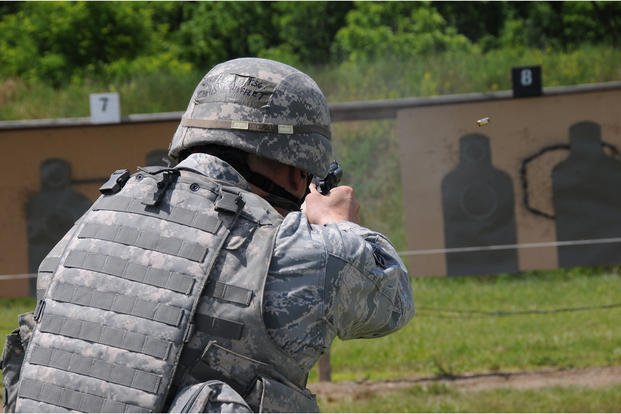As the only airborne psychological operations broadcasting unit, the 193rd Special Operations Wing maintains a very high operations tempo and deploys in numerous contingencies throughout the world.
The airborne radio and television broadcast mission originated in the mid-1960s with the EC-121 (known as Coronet Solo). The mission later transitioned to the EC-130E (1980) and eventually to the EC-130J (2004). Soon after the 193 SOW received EC-130s, the Air National Guard unit participated in the rescue of American citizens in Operation Urgent Fury in 1983. Then known as Volant Solo, the aircraft acted as an airborne radio station, keeping the citizens of Grenada informed about the U.S. military action. Several years later in 1989, Volant Solo was instrumental in the success of coordinated psychological operations in Operation Just Cause. During this mission, it broadcast throughout the initial phases of the operation, helping to end the regime of Gen. Manuel Noriega in Panama.
In 1990, the 193rd joined the newly formed Air Force Special Operations Command, and the wing's aircraft were redesignated Commando Solo, with no change in mission. In 1990-1991, Commando Solo was deployed to Saudi Arabia and Turkey in support of Operations Desert Shield and Desert Storm. Its missions included broadcasting the "Voice of the Gulf" and other highly successful programs intended to convince Iraqi soldiers to surrender.
In 1994, Commando Solo was used to broadcast radio and TV messages to the citizens and leaders of Haiti during Operation Uphold Democracy. President Jean-Bertrand Aristide was featured in these broadcasts, which contributed to the orderly transition from military rule to democracy. In 1996, Commando Solo was dispatched on short notice to the Balkans to broadcast information that ultimately led to the successful implementation of the Dayton Agreement that brought peace throughout Bosnia-Herzegovina.
In 1997, the 193 SOW and Commando Solo supported the United Nations' Operation Joint Guard with radio and TV broadcasts over Bosnia-Herzegovina in support of stabilization forces operations. In 1998, the unit and its aircraft participated in Operation Desert Thunder, a deployment to Southwest Asia to convince Iraq to comply with U.N. Security Council resolutions. The Commando Solo again was sent into action in 1999 in support of Operation Allied Force. The aircraft was tasked to broadcast radio and television into Kosovo to help prevent ethnic cleansing. In 2001, before one bomb dropped or multitudes of troops deployed, the Commando Solo aircraft broadcast messages to the local Afghan population and Taliban soldiers during Operation Enduring Freedom.
Between 2003 and 2006, the Commando Solo was deployed to the Middle East in support of Operation Iraqi Freedom. More recently, the EC-130J was redeployed to the Middle East in support of the Global War on Terrorism.
Units
112th Air Operations Squadron
The mission of the 112 AOS is to be an integral component for an Air Operations Center, which acts as the Joint Force Air Component Commander's (JFACC's) headquarters for running an air war. In short, the AOS's complex job is to produce logical plans for each day of a conflict, execute them and then evaluate their effects for input into the next day's plan.
148th Air Support Operations Squadron
The 148th Air Support Operations Squadron provides combat-ready Tactical Air Control Parties for combat maneuver units of the 28th Infantry Division, including the 56th Stryker Brigade Combat Team. Their primary job is to provide mission planning of direct combat air support and operate and supervise communications nets to support Air Force air resources and Army ground maneuver units.
201st Red Horse Squadron
The mission of the 201 Red Horse Squadron is to directly support combat air power and provide commander in chiefs (CINCs), and federal and state authorities a flexible, well-rounded, heavy construction and repair capability anytime, anywhere.
203rd Weather Flight
The 203rd Weather Flight is a small, elite unit that analyzes and predicts atmospheric conditions for pilots, war planners and decision makers. They go anywhere at any time and forecast for any type of flying mission or troop activity.
211th Engineering Installation Squadron
The mission of the 211 EIS is to engineer, install and relocate fixed command, control, communications and computer (C4) systems in facilities. The members of the 211 EIS are "above all others" in providing C41 communications capabilities to our nation, state and community.
271st Combat Communications Squadron
The 271st Combat Communications Squadron deploys, operates and maintains tactical communications packages in support of Air Force missions worldwide or civil and disaster-relief missions in Pennsylvania. The 271 CBCS can provide command and control satellite nets, intra-site telephone services, data services, tactical switchboard, communications center operations, network and multisite voice communications.
553rd Air Force Band
The Air National Guard Band of the Mid-Atlantic is assigned to the dual missions of supporting regional Air National Guard units through performances in ceremonies, activities and recruiting tours; and public relations concert tours for the Air National Guard and the "Total Air Force."
Lightning Force Academy
The Lightning Force Academy is committed to developing the level of knowledge and skill needed to train personnel to support the Engineering Installation (EI) mission (both active-duty and ANG). Students become familiar with the practices to accomplish the EI wartime mission: project engineering, management and total project oversight. Workload includes combat restoration, repair, installation, removal or relocation of communications-electronics equipment.
Regional Equipment Operators Training Site
The REOTS mission is to provide additional readiness training for upgrading proficiency levels of civil-engineer heavy equipment operators throughout the Defense Department.
History
From its inception as a pace-setting fighter squadron during World War II to its present role as the only Air National Guard special operations flying unit, the 193rd Special Operations Wing has remained at the tip of the spear.
Originated as the 347th Fighter Squadron on Oct. 1, 1942, by the U.S. Army Air Corps, the unit helped to establish air superiority for Allied Forces in Europe. On Nov. 7, 1945, the 347th was deactivated as an active-duty unit. On May 24, 1946, the mission was turned over to the newly allocated 148th Fighter Squadron, an Air National Guard unit located at Spaatz Field, Reading, Pa.
The 148th Fighter Squadron, flying P-51 "Mustangs," was federally recognized on Feb. 27, 1947.
On Dec. 22, 1950, the 148th Fighter Interception Squadron was notified it would be called to duty for the Korean conflict. From February 1951 to October 1952, the squadron became attached to the 26th Air Division as a part of the Eastern Air Defense Force, Dover AFB, Delaware.
In 1956, the end of an era came for the 148th as propeller-driven fighters were rapidly being replaced by larger aircraft. The 148th converted to the 140th Air Transport Squadron, with the main airframe being the C-46 "Commando" transports and later the C-119 "Flying Boxcar."
By the late 1960s, the 140th was notified that it would be converting once again to the much larger and faster C-121 "Constellation." Due to runway requirements, the C-121s could not fly from Spaatz Field, and the unit moved to Olmsted Air Force Base at its present-day location in Middletown, Pennsylvania. It was later renamed the 168th Air Transport Unit, Feb. 16, 1964.
Threatened by the closure of their host base and by downsizing of all conventionally powered transport aircraft -- Olmsted closed in 1969 and is now the site of the Harrisburg Air National Guard Base -- the National Guard Bureau volunteered the unit for a psychological warfare capability named "Coronet Solo."
Following the Arab-Israeli War of June 1967, psychological warfare once again became a U.S. military priority. The unit converted to the 193rd Tactical Electronic Warfare Group. Although the "Solo" mission was to remain consistent throughout the 40 years to follow, the capabilities of the 193rd remained shrouded in secrecy until it partially was declassified in 1989.
Today, the 193rd Special Operations Wing continues this proud tradition of maintaining the only airborne psychological operations broadcasting platform for the entire U.S. military.
Want to Know More About the Military?
Be sure to get the latest news about the U.S. military, as well as critical info about how to join and all the benefits of service. Subscribe to Military.com and receive customized updates delivered straight to your inbox.











